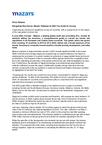Navigating New Norms: Mazars Releases its 2023 Tax Guide for Europe
25 May 2023, Europe – Mazars, a leading global audit and consulting firm, unveils its eleventh edition tax brochure, a comprehensive guide to current tax trends and regulations in 25 European and Central Asian countries. This guide, which has grown from covering 15 countries in 2013 to 25 in 2023, delves into a broad spectrum of tax issues, focusing on corporate income taxation, transfer pricing, employment, and sales taxes.
Mazars' analysis of regional taxation trends in 2023 reveals significant shifts in key areas. While minimum and average wages are experiencing an upward trajectory, the region is witnessing the conclusion of a period marked by reductions in wage-related taxes and social contributions. The European Union's concerted efforts against harmful tax competition have led to the impending incorporation of the global minimum tax into national legislation by year-end. Furthermore, the adoption of digital technology is revolutionizing value-added tax collection efficiency across the region. Additionally, transfer pricing rules have become intrinsic components of the tax systems in nearly all Central and Eastern European markets, as highlighted in the 2023 Tax Guide.
"Unveiling the Tax Guide now couldn't be more timely," commented Dr. Dániel H. Nagy, tax partner at Mazars. "In light of the impending 15% global minimum corporate tax rate set for 2024, it's essential for countries and corporations alike to comprehend the vast legislative adjustments and prepare accordingly."
The 2023 guide offers a detailed analysis of tax regimes across a range of countries including Central and South-Eastern Europe, Germany, Austria, Moldova, Ukraine, the Baltic States, and for the first time, Central Asian countries such as Kazakhstan, Kyrgyzstan, and Uzbekistan.
Regional countries exhibit varied corporate profit taxation, with average tax rates between 15 and 20 percent. In 2022, Austria alone reduced its tax rate, from 25 percent to 24 percent. While Hungary maintains the lowest tax rate at 9 percent, specific sectors may experience tax rates on profits as high as 50 percent.
Last year, following a fierce debate, EU countries agreed to adopt the global minimum tax rules of the EU directive into national legislation by 2023. The rules, referred to as Pillar II, mandate a minimum effective tax rate of 15%, which is the actual tax rate after applying various discounts and adjustments. This directive applies to multinational groups with at least €750 million turnover at the group level and at least one member operating in the EU.
While the specifics of the transposition into domestic tax law are still unclear, the primary legislative goal is anticipated to be maintaining competitiveness post-global minimum tax adoption. It is expected that other taxes, including local business tax and income tax on energy suppliers, might be considered in calculating the effective tax rate, Dr. H. Nagy added.
This year's guide also underscores the crucial role of advanced technology in the finance sector, demonstrating how its use in value-added tax (VAT) collection is enhancing efficiency and broadening the scope of revenue generation. The adoption of digital technology has allowed countries like Hungary and Croatia, which have high standard VAT rates, to ensure compliance and streamline their tax processes. "Technology's impact on the efficiency of tax collection cannot be underestimated," added Dr. H. Nagy. "Digital solutions have proven integral in combating tax evasion and abuse, and this will only become more important as we move forward."
In 2023, trends toward lower income and employment taxes halted, displaying stark differences among European countries. Some countries like Bulgaria and Ukraine maintain a uniform income tax rate, while others such as Austria and Slovakia adopted progressive taxation.
Employers’ social taxes and contributions average 16% of gross wages, with notable disparities between countries. A useful comparison metric, the tax wedge, indicates the proportion of total income paid to the state, which ranges from 14 to 48 percent across the region.
"Austria and Slovakia lead with the highest tax wedge," said Pavel Klein, CEE Tax Leader, noting wage levels vary significantly among countries. The minimum wage ranges from around €200 in Kosovo and Moldova to over €2000 in Slovenia, Germany, and Austria.
Despite high inflation, the average private sector wage level in euro terms only increased by about 5 percent over the past year.
The guide also gives a comprehensive look at sales taxes. The standard VAT rates average around 20%, with notable deviations on a country-to-country basis. The standard VAT rates of 27% and 25% in Hungary and Croatia are considered particularly high.

